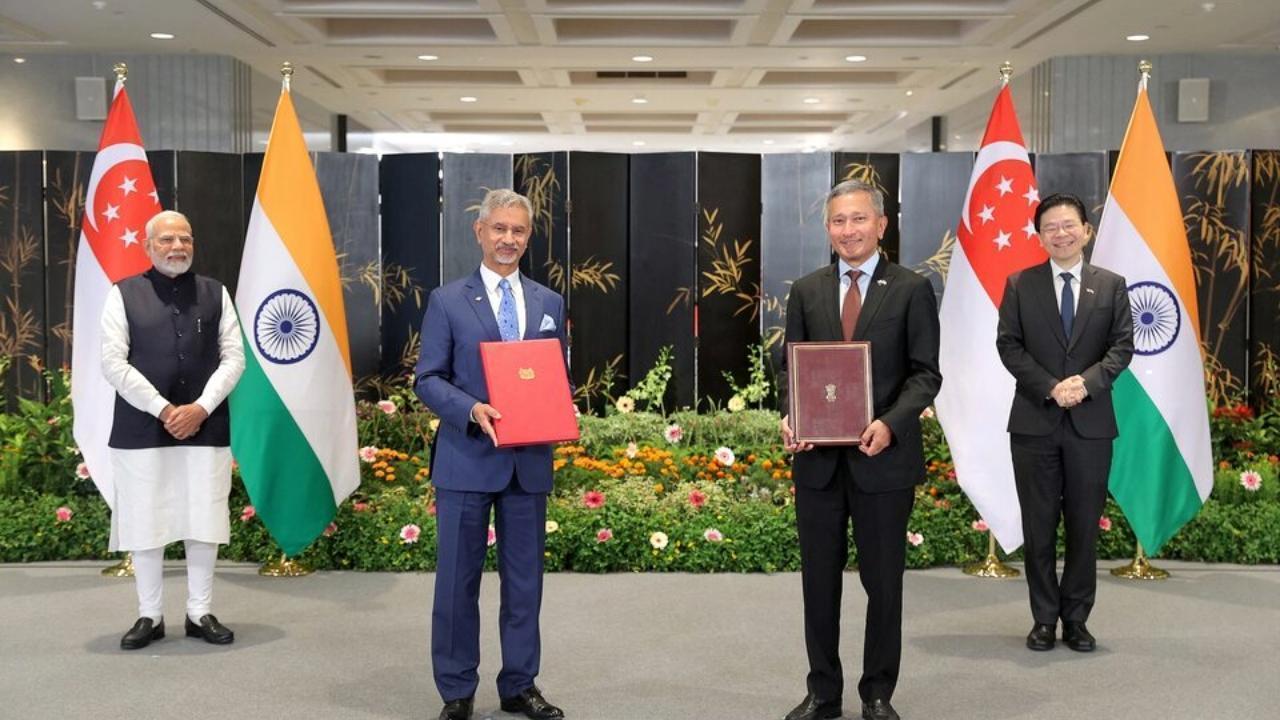
Join 10k+ people to get notified about new posts, news and tips.
Do not worry we don't spam!

Post by : Anis Farhan
Photo: Reuters
In a significant step toward the future of international commerce, India and Singapore have jointly launched the India–Singapore Digital Trade Corridor (ISDTC)—a cutting-edge platform that redefines how trade is conducted between the two economies. Officially announced in July 2025 during the 3rd ASEAN-India Digital Partnership Summit, the corridor aims to reduce trade friction, streamline logistics, and foster SME participation in digital exports.
By fusing blockchain-backed customs processing, e-invoicing frameworks, and interoperable digital identities, this corridor is expected to slash transaction times by 60% and reduce cross-border compliance costs by up to 35%.
The project places both nations at the forefront of a new global model of digital-first trade diplomacy—one that is efficient, inclusive, and secure.
Unlike traditional FTAs or customs integration treaties, the India–Singapore corridor focuses on digitizing every step of the trade process. The platform includes:
Mutual recognition of digital trade documents, including e-bills of lading and origin certificates.
Real-time customs clearance, enabled by blockchain timestamping and QR verification.
Cross-border e-wallet interoperability, easing payment settlements for SMEs and independent exporters.
Cybersecurity protocols and audit trails, jointly monitored by the Singapore Customs Authority and India’s Central Board of Indirect Taxes and Customs (CBIC).
This infrastructure is being built atop Singapore’s TradeTrust system and India’s Open Network for Digital Commerce (ONDC), with data localization and sovereignty preserved for both partners.
India and Singapore represent two of the region’s most digitally advanced economies, but historically, trade between them has faced bottlenecks due to manual documentation, currency conversion delays, and inconsistent product classification codes.
With bilateral trade volume surpassing $35 billion in FY 2024–25, this corridor addresses the non-tariff barriers that often affect speed and transparency, particularly for digital goods, pharmaceuticals, and electronics.
For Singapore, the move strengthens its role as Asia’s digital logistics hub. For India, it supports its ambition to become a global digital trade powerhouse, as outlined in its upcoming Digital Trade Facilitation Bill expected later this year.
One of the corridor’s standout features is its focus on small businesses. Micro-exporters, freelance designers, SaaS providers, and boutique manufacturers in India and Singapore will now be able to:
Register through a single digital identity, verified by both nations.
Use common product codes and harmonized tax classifications.
Access fintech-backed trade credit lines for low-volume exports.
This opens new doors for youth entrepreneurs and regional startup ecosystems, especially in sectors like e-learning, gaming, ethical fashion, and green tech.
The platform also provides AI-enabled compliance checks, ensuring startups don’t face penalties due to bureaucratic oversight or classification errors.
Despite its promise, the corridor is not without its complexities. There are concerns over data interoperability and cybersecurity, particularly for sensitive commercial records. To address this, both governments have agreed to:
Establish a Joint Data Oversight Committee, with quarterly reviews.
Mandate ISO-based data encryption and anonymization protocols.
Set up an SME Helpdesk and Dispute Redressal Forum accessible in both countries.
There’s also the risk of digital exclusion for offline businesses. To counteract this, India’s Ministry of Commerce has launched an outreach initiative across Tier-2 and Tier-3 cities, providing training, subsidies, and integration kits for traditional exporters.
The India–Singapore Digital Trade Corridor is more than a bilateral success—it is a prototype for a globally scalable trade architecture. With ASEAN, the EU, and the Commonwealth expressing interest in similar integrations, this corridor may soon connect with wider networks, creating a multi-nodal digital trade ecosystem.
As global trade increasingly becomes borderless in form but not in function, digital corridors like this are paving the way for smarter, faster, and fairer commerce.
This article is intended for general information only and does not constitute legal or trade compliance advice. For operational guidance, consult respective trade departments and government notifications.










Zohran Mamdani Clinches NYC Mayoral Seat as Victory Speech Blends Politics and Bollywood
Zohran Mamdani won New York City's mayoral race, becoming the city's first Muslim and South Asian ma

India Wins First Women’s World Cup 2025 Title
India lifts its maiden Women’s World Cup 2025 title! Harmanpreet Kaur’s team stuns South Africa in a

Manuel Frederick, 1972 Olympic Bronze Goalkeeper, Dies at 78
Manuel Frederick, a member of India’s 1972 Olympic bronze hockey team, has died in Bengaluru at 78 a

Muhammad Hamza Raja Wins IFBB Pro Card Puts Pakistan & UAE on Global Stage
Pakistani bodybuilder Muhammad Hamza Raja earns IFBB Pro Card in Czech Republic, showcasing Dubai’s

Shreyas Iyer’s Recovery Underway After Spleen Laceration in Sydney ODI
Shreyas Iyer is recovering after a spleen laceration sustained while taking a catch in the Sydney OD

Qatar Ready to Host FIFA U-17 World Cup 2025 in Aspire
Qatar confirms full readiness to host the FIFA U-17 World Cup 2025 from November 3–27, with world-cl